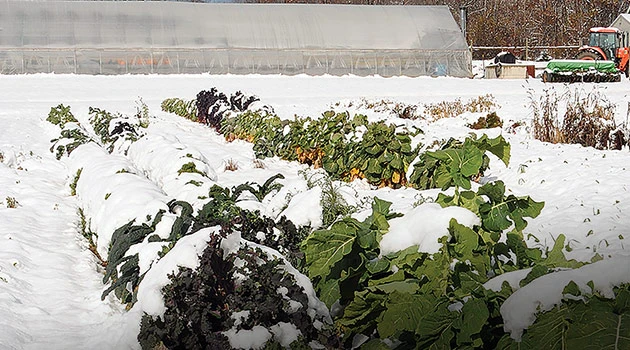How Should I Prep My Garden for Winter?
You may have heard that it’s important to prep your garden for the fall/winter seasons. Maybe folks have told you it’s important to “dress” or “amend” your soil, but what does that actually mean? Over the next few weeks, we’re going to take a dive into preparing your garden for winter.
First, let’s get through some basic definitions. People add all sorts of things to their soil, including fertilizers, compost, and mulch.
Most of these items fall into two basic categories: fertilizers and amendments. Fertilizers work on soil chemistry and are intended to increase the supply of nutrients in the soil. Amendments work on the physical structure of soil and are intended to do things like increase water drainage and aeration.
There are organic and synthetic options for both fertilizers and amendments. We STRONGLY encourage you not to use synthetics, as they can contaminate groundwater and have adverse affects on our health. Organic options also just work better for nearly every situation, which we’ll explain below.
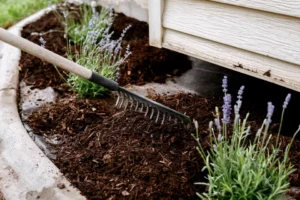
photo: thespruce.com
Mulch
Mulch can be considered a soil amendment because we generally add it to the soil to keep in moisture, discourage weeds from growing, minimize erosion and insulate the soil, rather than change the chemistry of the soil. Most soil amendments work best when they’re mixed into the soil, but mulch is a protective layer, so it just gets added on top of the soil.
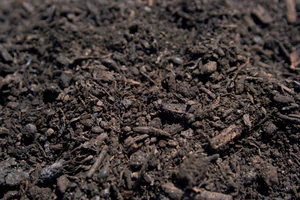
photo: tabletofarmcompost.com
Compost
Compost can count as both a soil amendment and a fertilizer because it improves physical soil structure and chemical soil health. And to further complicate things, compost can also be used as a mulch! Compost does a great job of retaining water and insulating the soil from temperature swings. And no matter if it’s applied as a mulch layer or mixed into the soil, the nutrients work their way into the soil.
So what should you do with your garden this fall?
The short answer is ‘it depends’. What do you plan on doing with it? Do you want to put your garden to bed until the Spring? Or do you want to grow crops or other plants in it over the winter?
Many people clear out summer plants, and add some compost, either as a top layer or by working it into the soil with a rake or rototiller. The idea behind this is that the soil needs a nutrient boost after nourishing plants all season. But this is a bit of an over-simplified view.
We often focus on growing healthy plants, when in reality what we need is healthy soil! If we “feed” the bugs and microorganisms in our soil, they in turn produce all the nutrients that our plants need and we see a direct positive impact in our gardens.
How do we feed our bugs (or “microbiome”)? You probably guessed it–compost! Most industrial agriculture in the US attempts to feed the soil with fertilizer, which generally contains nitrogen, phosphorus, and potassium, three key ingredients for plant growth. But these fertilizers do not have any beneficial bugs, bacteria, or microorganisms in them.
Think of it like handing someone a bag of flour, and a packet of yeast, but not giving them any kitchen implements like an oven, bowl, pot, spoon, or water. Do you think they’ll be able to bake a loaf of bread? Likely not. Compost on the other hand, has all those soil goodies in it, and so when we add it to the soil, it gets cooking!
Keeping this basic principle in mind, there are tons of options for your garden this fall/winter. Here are three basic plans to keep your soil’s microbiome happy:
Basic: Just add compost!
- Just add a layer of compost to your garden 1-3″ thick! This simple act is so powerful for your soil, and for the climate (it sequesters carbon!).
- If you want to take it up just a notch, cut down or pull out any of your plants that are past their prime, but leave them scattered in the garden. (Chop them up if they’re unwieldy.) And then add your compost on top. They’ll add nutrients to the soil as they break down over the winter.
Intermediate: Add compost and grow a cover crop
- Cut down or pull out any of your annual plants that are past their prime, but leave them scattered in the garden. (Chop them up if they’re unwieldy.)
- Remove weeds. (If you can, RESPONSIBLY burn any invasive species/seeds.)
- Add a layer of compost 1-3″ thick to your soil and gently rake it in. Unless you have a really stubborn pest problem, try not to till your soil. We want to keep all the carbon we can trapped inside of it.
- Plant a cover crop like red clover, winter rye, or hairy vetch. These are pretty hardy to the cold temperatures here in Durango. They’ll add diversity to the garden, keep the microbiome happy, and keep the soil protected. (We’ll go further into this in future posts.)
- Prune your perennial plants.
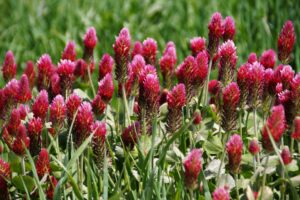
photo: almanac.com
Advanced: Grow winter crops
If you’re planning to grow winter vegetables, you can amend your soil with a layer of compost to help retain heat and moisture, plant your starts (pick cold-hardy varieties), and keep them warm (~above 20 degrees F). If you have a greenhouse, this can of course be a great place to keep plants warm. If not, you can create a row cover system or cold frame to keep in heat. Some folks have great success with double-layered row covers that have a layer of air space in between. This air pocket acts as a buffer to reduce heat loss. Be sure to pick vegetables that can handle some amount of frost at night, like cabbages, some kale, and many root veggies.
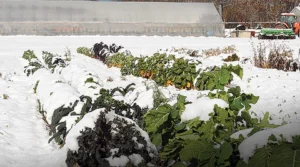
photo: johnnyseeds.com
There are so many creative ways to care for our gardens, and we encourage you to think outside the box. If you need compost, click here. And as always, we’d love to hear from you! If you have any questions, email us at hannah.tabletofarmcompost@gmail.com. Stay tuned for more winter gardening tips to come!
Some additional helpful resources:
Types of Mulch and how to use them
Fertilizers vs. Soil Amendments, Organic & Synthetic
Winter Cover Crops Seed Comparison Chart
How to Choose a Soil Amendment – a note on this fact sheet – our Table to Farm compost is STA-certified, and is regulated by the U.S. Composting Council, which you can read more about here.

